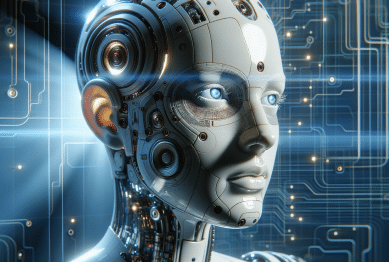AI breakthroughs are setting new records and changing industries rapidly. This article explores the current landscape of artificial intelligence news, from regulatory shifts to revolutionary AI tools, giving you an inside look at recent trends and what experts are discussing.
AI Regulation Updates Driving the Headlines
The world is paying close attention to artificial intelligence regulation news. From data privacy laws to ethical oversight, governments are updating policies amid rapid AI growth. The European Union’s AI Act has sparked global discussions. Its framework, focusing on transparency and accountability, aims to address ethical dilemmas while fostering innovation. Other regions, including the U.S. and parts of Asia, are watching these legal developments to inform their own approaches. These regulatory changes tap into a growing demand for responsible AI, especially as systems get smarter and more deeply embedded in daily life (Source: https://ec.europa.eu/info/business-economy-euro/banking-and-finance/digital-finance/eu-framework-artificial-intelligence-ai_en).
Companies worldwide must now navigate evolving compliance landscapes. Enterprises are establishing cross-functional teams to interpret new AI guidelines and assure the public about explainability, bias reduction, and user consent. This shift in focus impacts the newsroom as well, where editorial teams increasingly cover the rise of AI law, highlighting risks and opportunities. As AI becomes ubiquitous, clear communication and compliance help maintain public trust.
The surge in AI regulation news is also fueling public debate about surveillance, transparency, and job displacement. Communities are demanding more open discourse about algorithmic power. Lawmakers hope careful rulemaking will harness AI’s benefits while mitigating social risks. This evolving situation will likely generate ongoing coverage as more countries consider how to implement or update their AI regulatory efforts.
Breakout AI Tools Creating Buzz
In recent months, artificial intelligence tools have captured attention for their ability to create content, automate workflows, and unlock new research avenues. The announcement of cutting-edge models such as GPT-4 and chatbots directly impacts businesses and everyday users alike. Newsrooms highlight how AI writing assistants, voice synthesis platforms, and image generators are transforming both creative workflows and standard operations. As people experiment with advanced AI tools, real-world use cases make daily headlines (Source: https://www.nytimes.com/2023/03/14/technology/openai-gpt-4.html).
Adoption rates for AI tools are surging, spurred by their integration into leading platforms. Google, Adobe, and Microsoft have all embedded AI features into their productivity suites. This trend means even more people encounter artificial intelligence while editing documents, managing emails, or designing images. Each new feature release is covered by the press, delving into both the wow factor and questions around data use and intellectual property. Notably, AI’s ability to speed up processes makes headlines in both tech newsrooms and mainstream media.
The quick adoption and occasional backlash over generative AI highlight the need for informed reporting. News stories now commonly compare tool capabilities, explore limitations, and cover real-life impacts on users—ranging from artists to legal professionals. Journalists act as translators and watchdogs, helping readers understand what these emerging AI tools can do and what potential pitfalls exist. Platforms are also introducing ethical standards and feedback systems to keep up with public expectations (Source: https://www.npr.org/2023/06/13/1181647840/artificial-intelligence-tools-benefits-risks).
Shifts in Job Markets and Workplace AI Integration
AI’s rapid entry into the workplace is making waves across industries. News articles frequently discuss how automation and machine learning reshape job roles, salaries, and hiring requirements. From banking to healthcare, professionals find both efficiencies and new challenges. Large organizations invest in AI upskilling programs, aiming to help employees stay relevant. Some jobs evolve to include AI oversight, prompting demand for new skill sets and training opportunities. Surveys reveal a mix of optimism and concern as workers weigh AI’s ability to drive innovation versus the risk of being displaced (Source: https://www.oecd.org/newsroom/automation-and-artificial-intelligence-will-transform-jobs-says-oecd-report.htm).
The integration of AI in recruitment and human resources is also prominent in recent news. Companies adopt AI-driven platforms to sift resumes, forecast employee retention, and manage onboarding. News outlets cover real-world cases where AI-powered assessments improve fairness but sometimes trigger bias concerns. The ability to analyze massive datasets in hiring and performance assessment fuels debates on privacy and decision-making transparency.
Stories on workplace adaptation highlight areas where humans and AI collaborate rather than compete. There’s growing interest in hybrid job models, where employees partner with AI systems to boost productivity. Case studies show improved problem-solving in project management and logistics when humans work alongside automated solutions. The changing nature of work is a recurring headline, signaling a lasting conversation about the best ways to prepare the labor force for future AI disruption (Source: https://www.brookings.edu/articles/automation-and-artificial-intelligence-how-machines-affect-people-and-places/).
AI in Healthcare and Scientific Discoveries
The intersection of AI and healthcare has become a major focus in news coverage. Health systems leverage deep learning for diagnostics, drug discovery, and personalized care plans. Recent headlines showcase how hospitals implement AI to interpret X-rays and MRI scans, resulting in faster diagnoses and improved accuracy. Researchers develop algorithms that can identify patterns in huge data sets, helping clinicians discover new treatment paths. Policy makers and ethicists weigh in regularly, discussing the balance between innovation, patient consent, and data protection (Source: https://www.nih.gov/news-events/nih-research-matters/how-ai-changing-health-care).
A surge in scientific AI research sparks continual media interest. News articles detail how AI models simulate protein folding, predict weather patterns, or accelerate vaccine design. These breakthroughs accelerate the pace of scientific discovery, making headlines for their potential to impact public health, agriculture, and environmental policy. Early-stage pilot programs and research studies provide a steady stream of emerging news about scientific progress powered by AI.
Global health agencies are also increasingly investing in AI pilot programs. Public health organizations use machine learning to monitor disease outbreaks and run simulations for pandemic preparedness. Regular news segments discuss the ethical and technical hurdles, including algorithmic bias and the need for diverse training data. As institutions share results, the coverage helps keep citizens informed and involved in discussions around AI’s role in healthcare delivery.
Public Reactions and Ethical Considerations
The proliferation of artificial intelligence in daily life fuels robust ethical discussions in the news. Commentators, academics, and citizens raise concerns about privacy, bias, misinformation, and job security. Stories cover public forums, open letters from tech leaders, and protests over contentious applications. Readers encounter in-depth analysis about how governments and companies work to address algorithmic transparency and fairness, emphasizing continuous stakeholder engagement.
Ethical AI frameworks are under scrutiny from journalists and think tanks. New guidance documents, such as national AI ethics boards and international coalitions, are regularly covered by the press. Organizations explore methods to make AI explainable, with a focus on inclusive design and fairness audits. Newsrooms collaborate with fact-checkers to report on the effectiveness of these measures, helping audiences separate genuine progress from mere marketing claims.
Featured commentary in media covers the “human-in-the-loop” model, where ethical oversight is built into AI development. AI literacy campaigns grow as experts recommend ways to empower users, ensuring more people understand and question machine decisions. This ongoing conversation helps shape broad social perspectives and will influence future AI regulation and innovation (Source: https://plato.stanford.edu/entries/ethics-ai/).
AI Newsroom Innovations and Future Coverage
Today’s newsrooms experiment with artificial intelligence to automate reporting and augment editorial workflows. AI tools transcribe interviews, generate news alerts, and detect misinformation. Editors leverage headline optimization and content recommendation systems powered by machine learning to improve audience engagement. These capabilities allow journalists to dedicate more time to investigative reporting while ensuring news arrives at the speed readers demand.
Innovations in newsroom AI extend to real-time analytics, fact-checking assistants, and translation engines that make global news more accessible. News organizations now collaborate with researchers to refine AI tools, ensuring fair coverage and minimizing the spread of disinformation. These changes foster a rich environment for the ongoing evolution of journalism. As machine learning advances, newsrooms will continue to evolve rapidly, setting trends for the wider media landscape.
The future of AI in the news industry looks dynamic. As more organizations adopt smart technologies, the pace of reporting is expected to increase. Media outlets continuously invest in staff training and public AI literacy, keeping audiences informed about emerging developments. Ongoing coverage will spotlight new breakthroughs, policy shifts, and the ethical boundaries that shape the ever-changing world of artificial intelligence news.
References
1. European Commission. (2023). Artificial Intelligence. Retrieved from https://ec.europa.eu/info/business-economy-euro/banking-and-finance/digital-finance/eu-framework-artificial-intelligence-ai_en
2. Metz, C. (2023). GPT-4 Is OpenAI’s Most Advanced System. Retrieved from https://www.nytimes.com/2023/03/14/technology/openai-gpt-4.html
3. NPR. (2023). Benefits and Risks of Artificial Intelligence Tools. Retrieved from https://www.npr.org/2023/06/13/1181647840/artificial-intelligence-tools-benefits-risks
4. OECD. (2023). Automation and Artificial Intelligence Will Transform Jobs. Retrieved from https://www.oecd.org/newsroom/automation-and-artificial-intelligence-will-transform-jobs-says-oecd-report.htm
5. National Institutes of Health. (2023). How AI Is Changing Health Care. Retrieved from https://www.nih.gov/news-events/nih-research-matters/how-ai-changing-health-care
6. Stanford Encyclopedia of Philosophy. (2023). Ethics of Artificial Intelligence and Robotics. Retrieved from https://plato.stanford.edu/entries/ethics-ai/









